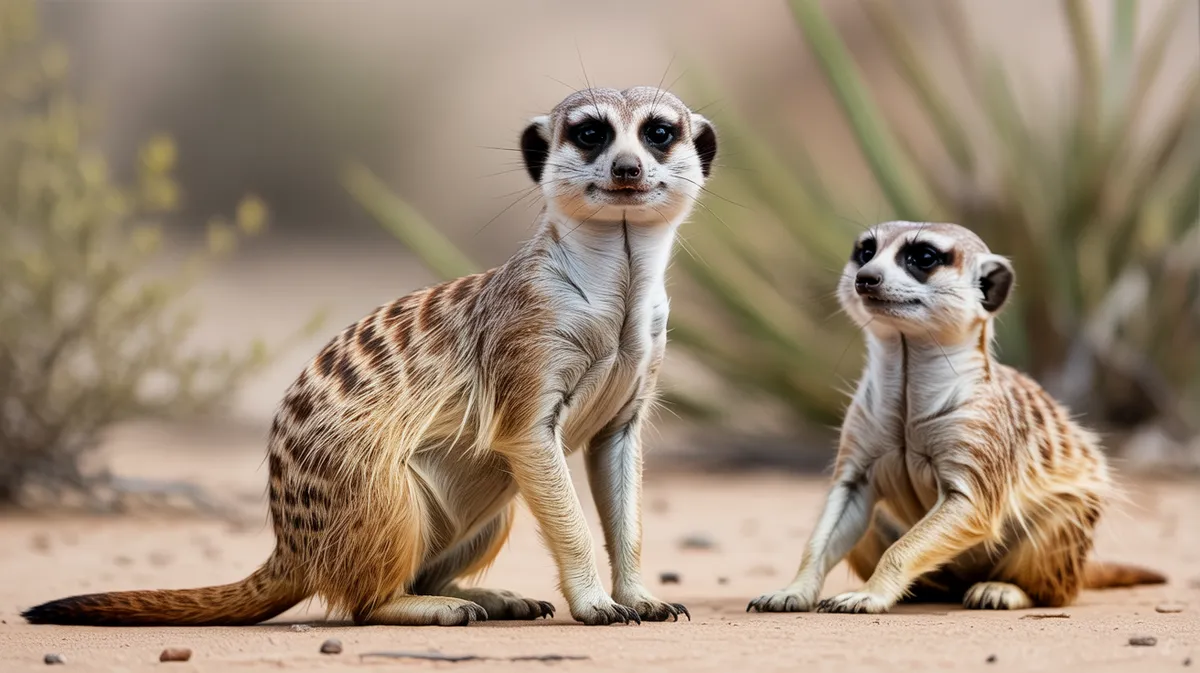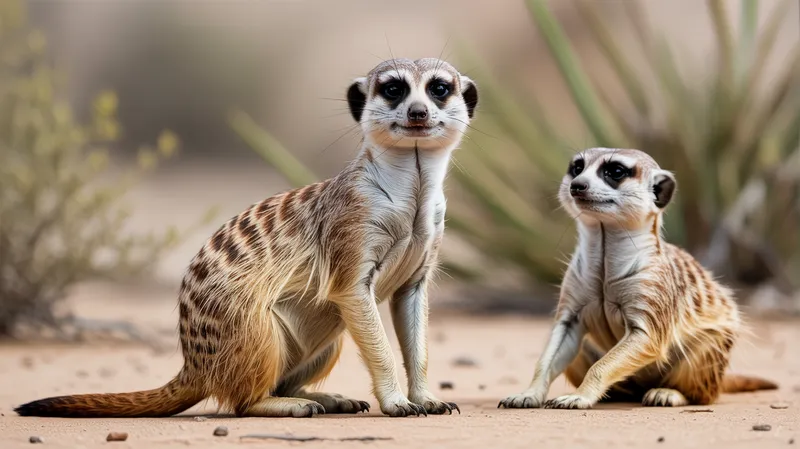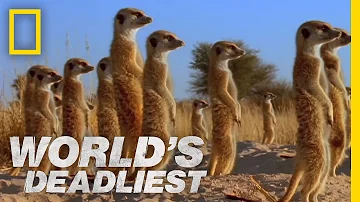
Meerkat
Suricata suricatta

Meet the Meerkat
The meerkat is a small, social mongoose native to the arid regions of southern Africa. Known for their upright, sentinel-like posture, meerkats live in large, cooperative groups called mobs or gangs, where they share responsibilities such as babysitting and foraging. They are highly adaptive, using complex vocal communication and teamwork to evade predators and locate food. Their burrowing lifestyle and communal behaviors make them one of the most fascinating mammals in the African savanna.
Classification
Mammal
Habitat
Arid savanna and open desert
Diet
Omnivore
Lifespan
6-14 years
Conservation
Least Concern
Weight
0.62–1 kg
📖Fascinating Facts
Excellent Lookouts
Meerkats take turns acting as sentinels, standing on their hind legs to watch for predators and warning the group with specific alarm calls.
Venom Resistance
Meerkats can safely eat scorpions and certain venomous insects, as they have evolved a resistance to their toxins.
Complex Burrow Systems
They construct elaborate underground burrows with multiple entrances and chambers, providing shelter and protection from the harsh desert environment.
📋Detailed Description
The meerkat (Suricata suricatta) is a small, slender carnivoran belonging to the mongoose family (Herpestidae), native to the arid and semi-arid regions of southern Africa, including the Kalahari Desert and parts of Namibia, Botswana, Angola, and South Africa. Adults typically measure 24–35 cm in head-and-body length, with a tail extending 17–25 cm, and weigh between 620 and 970 grams. Their fur is short and brindled, ranging from light gray to yellowish-brown, with poorly defined dark bands across the back and a dark tip on the tail. Meerkats have a broad head, large eyes with dark patches that reduce sun glare, a pointed snout, and elongated limbs; their forelimbs possess strong, non-retractable claws up to 2 cm long, specialized for digging. Socially, meerkats are highly cooperative and live in groups, or 'mobs,' typically comprising 10–30 individuals but sometimes exceeding 50. These groups are structured around a dominant breeding pair and their offspring, with subordinate adults assisting in pup rearing and sentry duties. Meerkats are diurnal and spend much of their day foraging above ground, while nights are spent in elaborate burrow systems that provide protection from predators and extreme temperatures. Their diet is omnivorous, consisting mainly of insects, arachnids, small vertebrates, eggs, and plant matter. Communication is complex, involving a wide repertoire of vocalizations for coordination, alarm, and social bonding. Their remarkable thermoregulatory abilities and behavioral flexibility enable them to thrive in harsh desert environments.
💡 Did you know?
A meerkat mob can have up to 50 members, all working together to protect and raise their young.
🔬Research & Sources
Wikipedia Summary
The meerkat or suricate is a small mongoose found in southern Africa. It is characterised by a broad head, large eyes, a pointed snout, long legs, a thin tapering tail, and a brindled coat pattern. The head-and-body length is around 24–35 cm (9.4–13.8 in), and the weight is typically between 0.62 and 0.97 kg. The coat is light grey to yellowish-brown with alternate, poorly-defined light and dark bands on the back. Meerkats have foreclaws adapted for digging and have the ability to thermoregulate to survive in their harsh, dry habitat. Three subspecies are recognised.
Last Modified: 5/24/2025
🎭Behavior & Social Structure
Meerkats exhibit a highly organized social system with distinct roles, including sentinels, babysitters, and foragers. Sentinels take turns standing upright on elevated positions, scanning for predators such as birds of prey, and emit specific alarm calls to warn the group. Foraging is typically a group activity, with individuals using their keen sense of smell and dexterous forepaws to dig for insects, scorpions, and small vertebrates. They are known to be immune to certain venoms, allowing them to prey on scorpions and some snakes. Social interactions include grooming, play, and coordinated mobbing of predators. Daily routines involve emerging from burrows at sunrise, sunbathing to raise body temperature, followed by several hours of foraging interspersed with periods of rest and social interaction. At midday, especially during hot weather, meerkats may retreat to their burrows to avoid overheating. Territorial disputes between neighboring mobs can be intense, involving vocalizations, scent-marking, and occasional physical confrontations.
👶Reproduction & Life Cycle
Meerkats are cooperative breeders, with typically only the dominant female and male in a group producing offspring, while subordinates assist with pup care. Breeding can occur year-round, but peaks are often observed during the rainy season when food is more abundant. The gestation period lasts approximately 70–77 days, after which the dominant female gives birth to a litter of 2–5 pups (occasionally up to 7) in a secure burrow chamber. Pups are born altricial—blind, hairless, and weighing about 25–36 grams. They remain underground for the first 2–3 weeks, during which time they are nursed exclusively by the mother. After emerging, pups are cared for by all group members, who provide food, protection, and teach foraging skills. Weaning occurs at around 6–9 weeks, but juveniles continue to rely on adults for guidance and protection for several months. Infanticide by dominant females, targeting the offspring of subordinates, is documented and serves to maintain reproductive monopoly.
🛡️Adaptations & Survival
Meerkats possess a suite of physical and behavioral adaptations for desert life. Their dark eye patches reduce solar glare, enhancing vision in bright environments. The long, curved claws are specialized for efficient digging, both for prey and for constructing extensive burrow systems that buffer temperature extremes and provide refuge from predators. Meerkats can close their ears to keep out sand while digging. Their social structure, with cooperative breeding and sentinel behavior, enhances group survival by distributing risk and increasing vigilance. Thermoregulation is achieved through behavioral means, such as sunbathing in the morning and seeking shade or burrows during peak heat. Physiologically, meerkats have a high tolerance for dehydration and can derive most of their water needs from food. Immunity to certain venoms, such as those of scorpions, is conferred by specialized serum proteins.
🎨Cultural Significance
Meerkats hold a prominent place in popular culture, often symbolizing vigilance, cooperation, and curiosity. They feature in African folklore and are sometimes associated with sun deities or as omens in local traditions. Globally, meerkats have gained fame through wildlife documentaries, animated films (e.g., 'The Lion King'), and as mascots for organizations and products. In some southern African communities, meerkats are respected for their role in controlling insect pests, though there are no significant traditional uses for their body parts.
🔬Recent Research & Discoveries
Recent research on meerkats has focused on the evolution of cooperative breeding, kin selection, and social cognition. Long-term field studies, particularly those conducted by the Kalahari Meerkat Project, have revealed complex social dynamics, including dominance hierarchies, reproductive suppression, and teaching behaviors. Studies have shown that meerkats use referential alarm calls that distinguish between aerial and terrestrial predators, demonstrating advanced vocal communication. Genetic analyses have clarified subspecies boundaries and population structure. Ongoing research investigates the physiological mechanisms underlying venom resistance and the impact of climate variability on group survival and reproductive success.
🎥Wildlife Videos

The Meerkats And Unique Animals That Are Masters Of The Desert | Natural Habitat Documentary
From the coldest ice slopes to the hottest sand dunes, the world is full of hostile landscapes that challenge the animals that live ...
Wild Habitat - Nature Documentaries

Birth of the Meerkat Pups | Ella: A Meerkat's Tale (BBC) | Nature Documentary | Reel Truth Earth
Ella, A Meerkats Tale is a 2008 Oxford Science Film following the events of two year old Ella Pandora. Young Ella faces isolation ...
Banijay Wild

Meerkats - The Movie
An inspiring exploration of one family's resilience and fortitude shot using innovative and groundbreaking filming techniques.
MSJK Media

Meerkats' Mob Rule | World's Deadliest
#NatGeoWILD #WorldsDeadliest #Meerkats About World's Deadliest: World's Deadliest Predators is a new series that looks at ...
Nat Geo Animals

Don't Mess with the Meerkats | Wildlife Icons Ep104
Meerkats may be small and vulnerable, but they're tenacious characters. Together, they're a force to be reckoned with. For this ...
Love Nature

4K African Wildlife - Cute Meerkats and Squirrels - Wild Animals of Africa
Join us on this amazing adventure to South Africa and immerse yourself in the true natural world of meerkats and ground squirrels ...
4K Relaxation Channel
🌍Habitat Information
The Meerkat typically inhabits Arid savanna and open desert environments. Meerkats have adapted to their environments with specialized features and behaviors.
Primary Habitat:
Arid savanna and open desert
More detailed habitat information will be available soon.
🛡️Conservation Status
The Meerkat is currently classified as Least Concern. Conservation efforts are crucial for preserving this species for future generations.
Common Threats:
- 🏠Habitat loss and fragmentation
- 🌡️Climate change impacts
- 🎯Hunting and poaching
- 🏭Human-wildlife conflict
⚠️Threats & Conservation Challenges
While the IUCN lists meerkats as Least Concern due to their wide distribution and stable population, local threats include habitat loss from agricultural expansion, overgrazing, and human encroachment. In some regions, meerkats are persecuted as pests or captured for the illegal pet trade. Disease outbreaks, such as rabies and canine distemper, pose episodic threats to populations. Climate change, with its associated impacts on rainfall patterns and food availability, may affect future population dynamics. Natural predators include raptors (e.g., martial eagles), jackals, and snakes. Despite these challenges, meerkats are highly resilient, aided by their flexible social structure and adaptability.
🔬Scientific Classification
Scientific Name
Suricata suricatta
Classification Hierarchy
🔍 About Taxonomic Classification
Taxonomic classification is a hierarchical system used by scientists to classify and organize living organisms based on shared characteristics and evolutionary relationships.
The system moves from broad categories (Kingdom) to increasingly specific ones, with each animal's scientific name typically consisting of its Genus and species.
📝Community Notes
Share your observations and insights about the Meerkat with our community of wildlife enthusiasts.
Join Our Community
Sign in to share your observations and connect with fellow wildlife enthusiasts.
Sign In to ContributeNo community notes yet
Be the first to share your observations about the Meerkat!
Explore Meerkat
Select a tab above to learn more about this amazing animal.
📸Photo Gallery
No photos available for this animal yet.
🌟Discover More Wildlife
Continue your journey of discovery with more fascinating animals from our database
